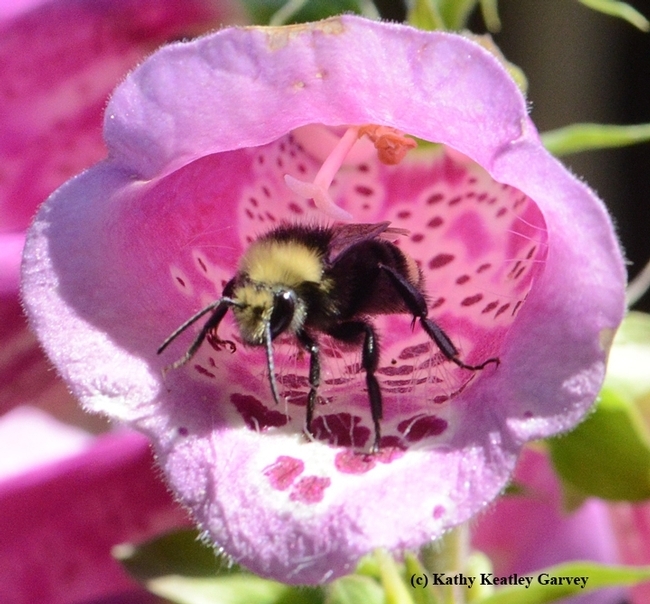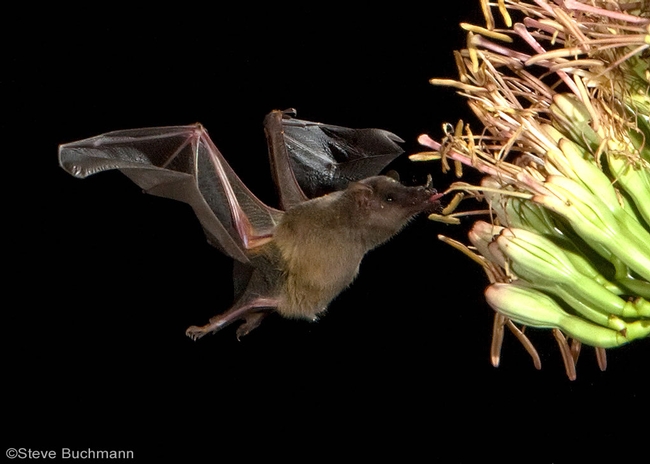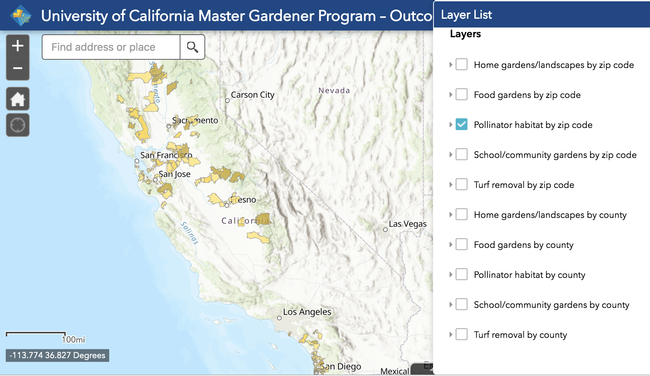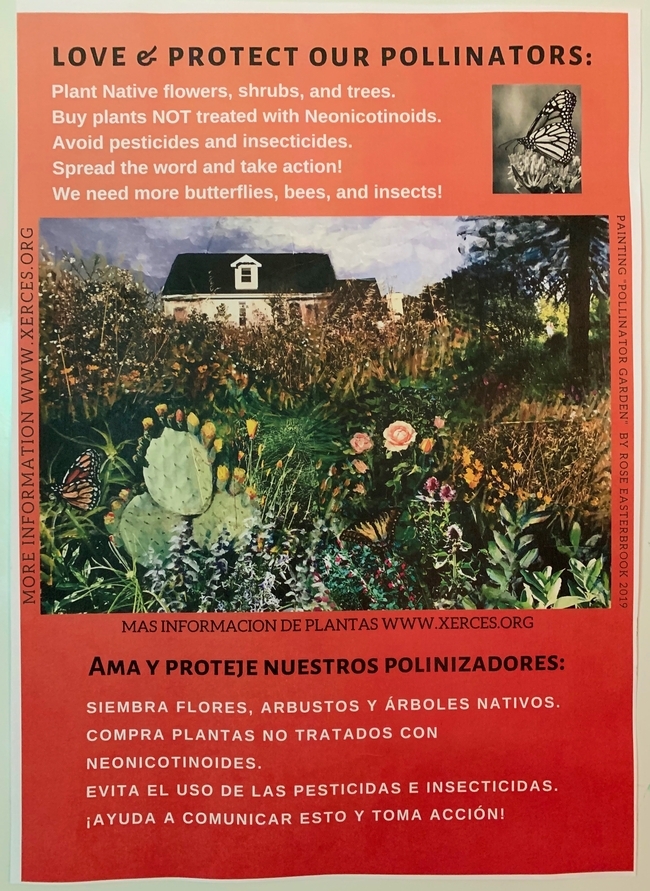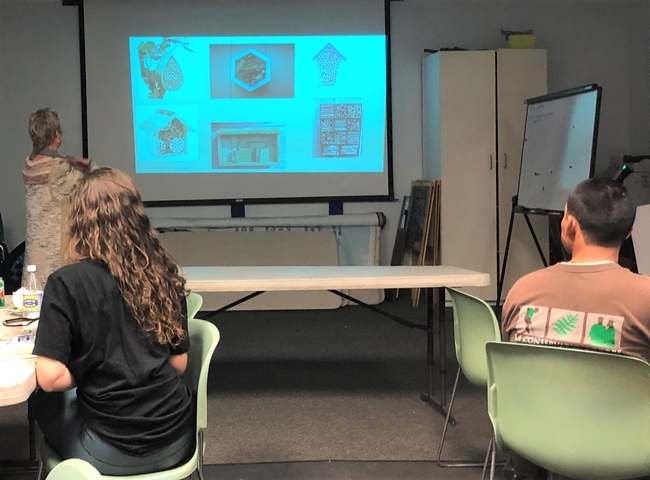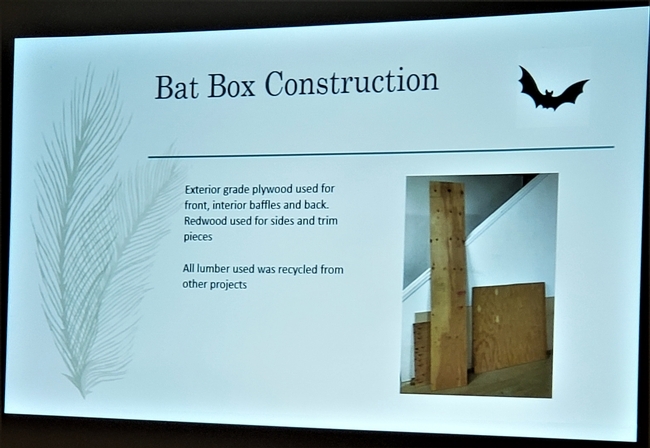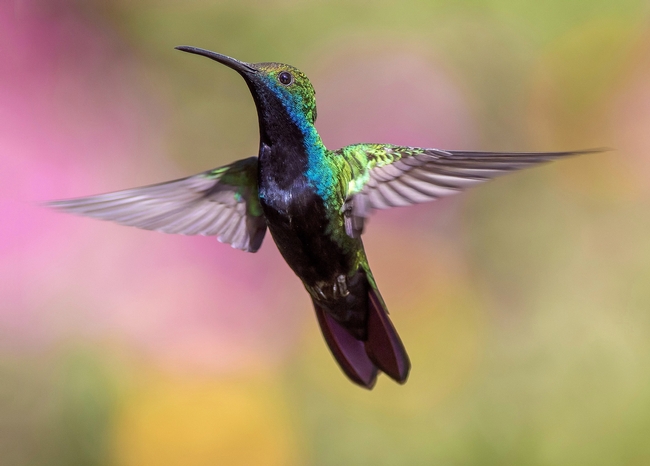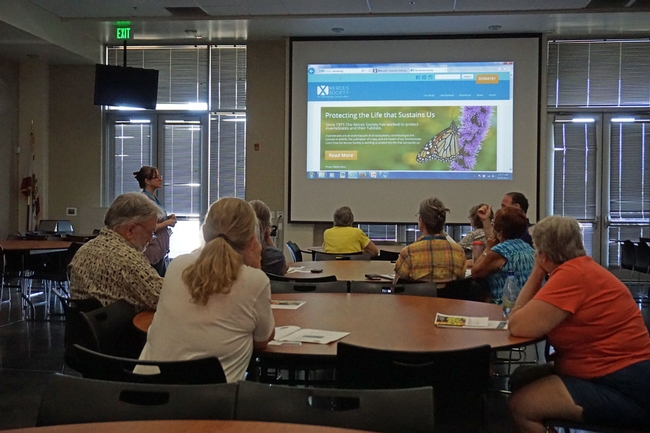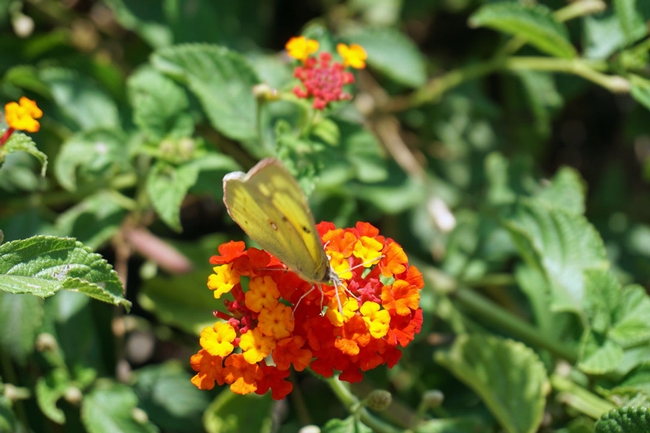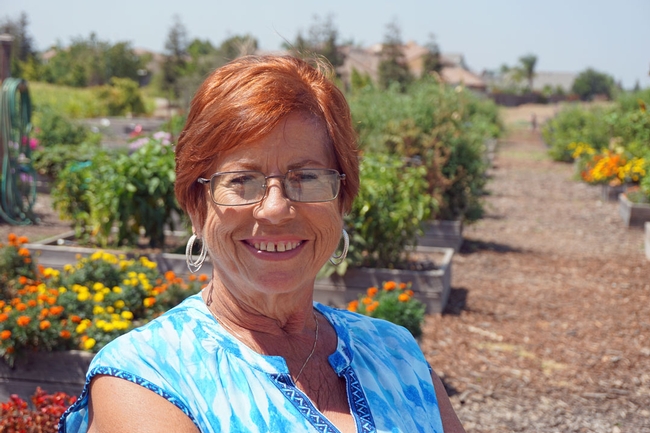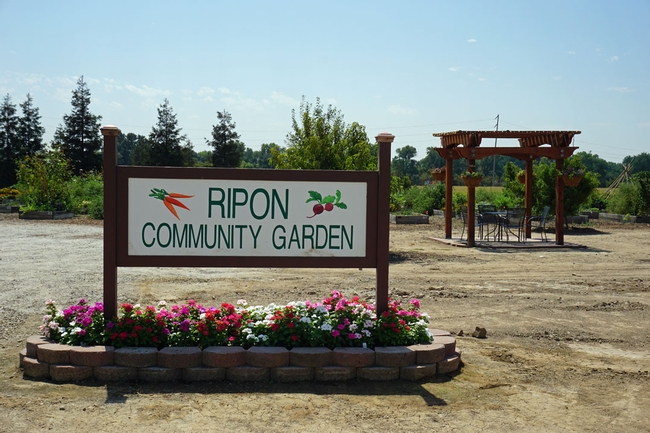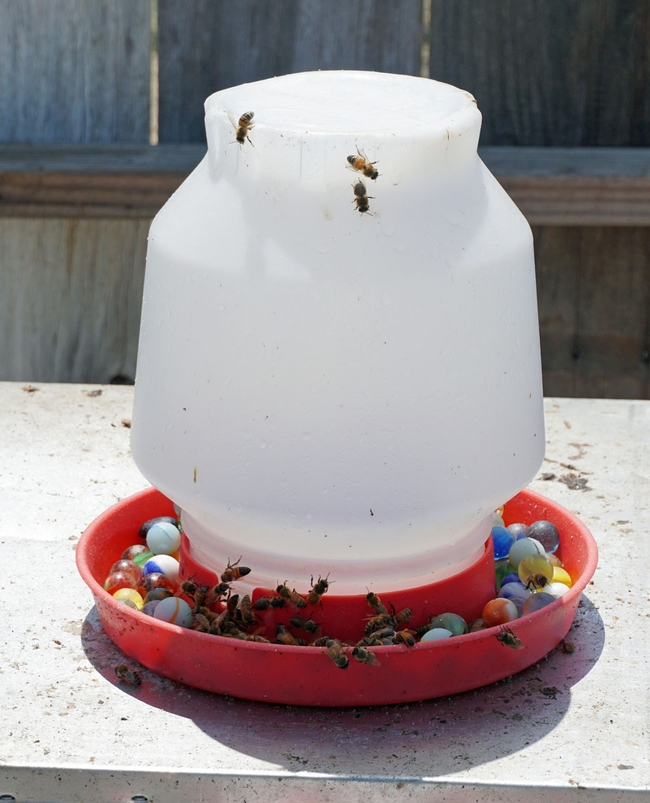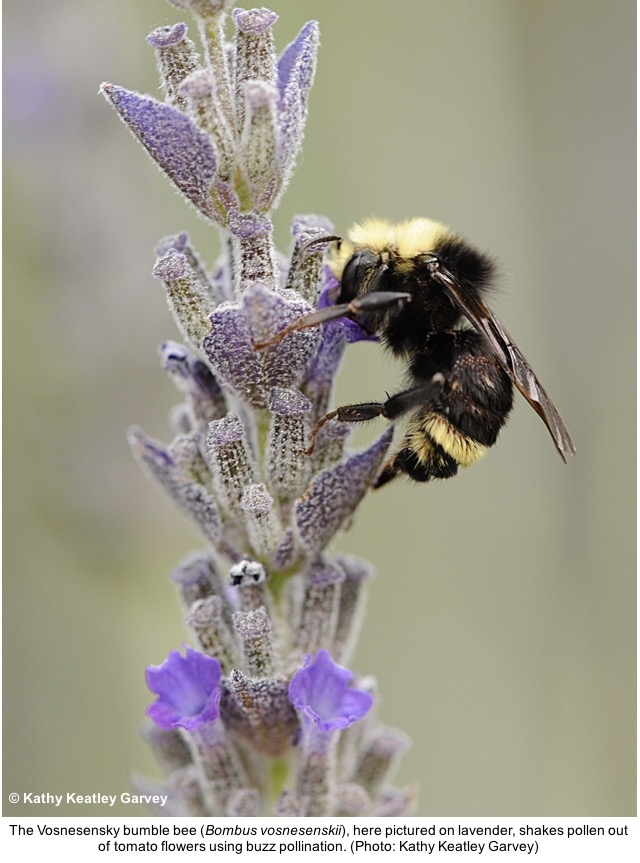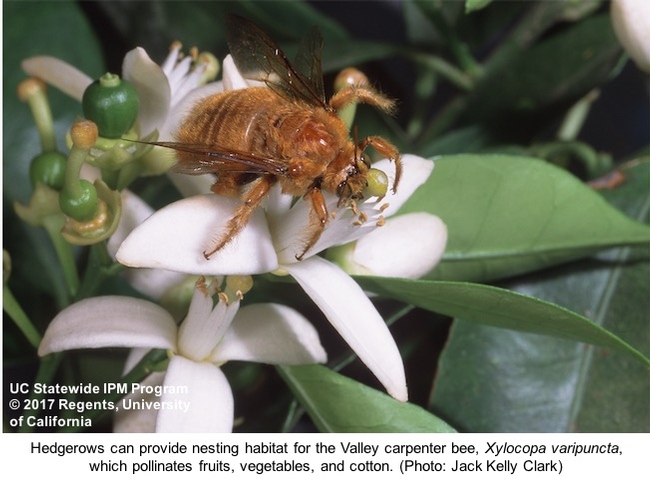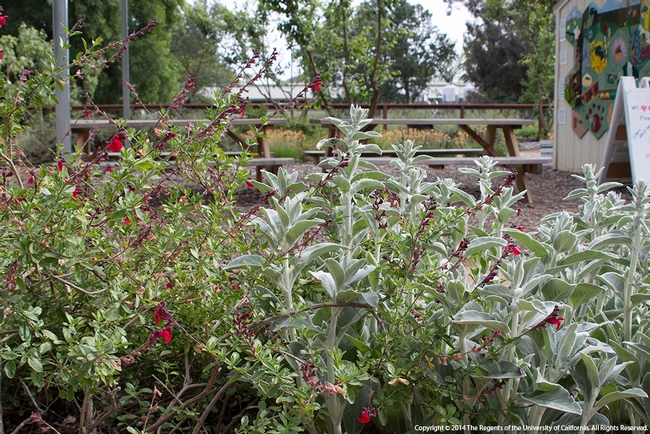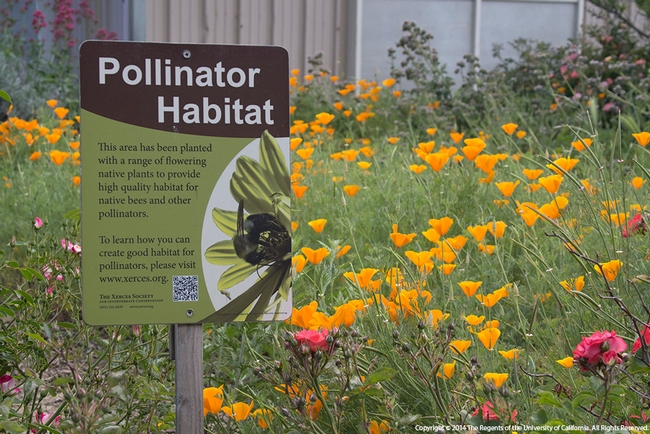Posts Tagged: pollinators
We depend on pollinators
Happy Pollinator Week! For 2019, it's June 17-23. Most people think of bees when they think pollination, but don't stop there. “Think the "b" alliteration: bees, birds, butterflies, bats and beetles. But don't forget the flies, ants, mosquitoes and moths!” writes Kathy Keatley Garvey in her Bug Squad blog.
Did you know…
- Three-fourths of the world's flowering plants depend on pollinators
- 35% of the food we eat depends on pollination by animal pollinators
- There are 25,000 different species of bees
- 1.6 million colonies of honey bees are needed to pollinate California's 800,000 acres of almond trees.
- Honey bees will fly up to 4 miles from the hive to collect water, nectar and pollens.
“Loss of a species, especially a pollinator, diminishes our global environment,” said the late bee expert Robbin Thorp, distinguished emeritus professor of entomology at the University of California, Davis, in a 2010 interview. “Bumble bees provide an important ecological service--pollination. This service is critical to reproduction of a huge diversity of plants that in turn provide shelter, food (seeds, fruits) to diverse wildlife. The potential cascade of effects from the removal of even one localized pollinator may affect us directly and indirectly.”
Launched 12 years ago, National Pollinator Week focuses on the valuable ecosystem services provided by bees, birds, butterflies, bats and beetles, according to Pollinator Partnership, which manages the national celebration. Other pollinators include syrphid or hover flies, mosquitoes, moths, pollen wasps and ants. They transfer pollen from the male anther of a flower to the female stigma.
Bats are very important pollinators in tropical and desert climates. More than 300 species of fruit depend on bats for pollination.
UC ANR's California Naturalist Program promotes environmental literacy and stewardship through discovery and action. To become a certified California Naturalist, participants enroll in a course with one of our partner organizations. To receive certification, every UC California Naturalist completes a capstone project that benefits nature. Many California Naturalist projects benefit pollinators. For example, California Naturalist Cynthia from the USC Sea Grant SEA LAB course made houses to support native mason bee population in Palos Verdes. She made the bee houses out of repurposed scrap wood and cardboard, paper coat hanger tubes, used toilet paper and paper towel rolls, and giftwrap rolls.
To create habitat for pollinators in your garden, the UC Master Garden Program recommends planting a variety of plants to provide diverse sources of nectar and pollen. The UC Master Gardener volunteers in San Mateo and San Francisco counties have compiled a list of pollinator-friendly plants.
The UC Master Gardener volunteers also collected data on pollinator habitat in California by zip code and created an interactive map.
California Naturalists' efforts benefit pollinators
'Attention is the beginning of devotion' --Mary Oliver
This quote resonates this month, amidst a variety of environmental holidays and celebrations including World Environment Day, World Ocean Day, California Invasive Species Action Week, and finally National Pollinator Week (this week) and Month. It seems in this increasingly digitally connected world, one day, week, or month doesn't pass us by in the calendar year without an official opportunity to observe, act, or celebrate nature.
As these official observances pop up, we can also contemplate all the unofficial ways people celebrate, protect, and educate about nature in their daily lives. There are both small and incremental and heroic acts taken every day to make this a more livable world for all creatures. There is momentum behind a movement that says “we're paying attention and the environment is worth our time and energy and devotion despite all the other worthy competing causes.”
In celebration of National Pollinator Week, we want to highlight just a few of the many California Naturalists whose efforts benefit pollinators. Every UC California Naturalist completes a capstone project of their choice to receive certification. These final projects require at least eight hours of volunteer service, and are often built upon by subsequent naturalists in following cohorts. They always benefit nature, and often benefit the recipient communities and organizations. Most California Naturalists would tell you they benefit the individual, too. Capstone projects are a culmination of service, learning, and “paying it forward.” Our community celebrates both the projects and the creativity, labor, and intentions of these naturalists.
Inspired by the intersection of science and art, California Naturalist Rose from the Hopland Research and Extension Center created this gorgeous outreach poster in both English and Spanish from her original pollinator garden painting for the Redwood Valley Outdoor Education Project. Her goal is to spread awareness of the important ecological roll our native pollinators play and to share Xerces Society resources. Animal pollinators include bees, butterflies, moths, wasps, flies, beetles, ants, bats and hummingbirds. According to Xerces Society, the ecological services that pollinators provide is necessary for the reproduction of over 85% of the world's flowering plants, including more than two-thirds of the world's crop species. Honeybees get a lot of media attention, yet many other pollinator species like native bumblebees are in precipitous decline. The UC Berkeley Urban Bee Lab is another excellent source of native bee information.
California Naturalist Cynthia from the USC Sea Grant SEA LAB course made houses to support native mason bee population in Palos Verdes, CA. The bee houses were made from repurposed scrap wood and cardboard, paper coat hanger tubes, used toilet paper and paper towel rolls, and giftwrap rolls. She reached out to a local Girl Scout troop to help make three types of houses. The Girl Scouts leveraged the new learning opportunity and service work to receive an "Outdoor Journeys" badge. Then she met with four kindergarten classes of 24 students each and together built houses to take home. The houses in the picture aren't examples of her model but were ones she found online.
Mason bees are solitary bees named for their behavior of using mud in constructing their nests. Mason bees may defy some assumptions about bees. They don't sting, they don't live in a hive, and they don't make honey. They do, however pollinate flowers and fruits and vegetables and need a safe place to lay their eggs. When available, some species use hollow stems or holes in wood made by wood-boring insects which is where mason bee houses come into the picture. UC Davis Department of Entomology compiled this list of resources on where to find and how to make nesting sites for native bees.
Sue from the Tuleyome course built bat boxes for her local home owners association to hang in Arnold, Calaveras County. At least 45 species of bats inhabit the United States and Canada and there are at least 27 known species of bats in California. Bats are very important pollinators and seed dispersers, particularly in tropical and desert climates. In addition, they serve a very effective agricultural pest control purpose. Although they provide vital environmental services, bat populations are in decline globally. To make your own bat boxes, UC ANR offers a guide to build songbird, owl and bat boxes.
UC Master Gardeners' 5 tips to boost beneficial bees
With a little care and planning, anyone can make their little corner of the earth safe and friendly for bees.
UC Master Gardener volunteer Clare Bhakta of San Joaquin County shared bee-friendly strategies during a community workshop in August, extending the reach of research information developed by UC Agriculture and Natural Resources.
"Lure bees in," Bhakta said. "If you make it comfy, they will come."
Bhakta is a newly minted Master Gardener, having graduated in June from the intensive training program presented by UC advisors and specialists. She is part of the San Joaquin County MG speakers bureau; the "Buzz about Bees" was her inaugural engagement.
"We want bees in our gardens," Bhakta said. "Ninety percent of flowering plants and 75 percent of human crops depend on pollinators, including bees. Bee pollination makes about $15 billion in human food in the United States each year."
About 1,600 species of bees are found in California, many of them natives. Most of the bee species live independently, occupying holes in trees trunks or branches, or in the ground. Their sizes range from inch-long metallic black bumble bees to tiny sweat bees 3 millimeters in length. These species rarely sting since they don't have hives to protect.
California's most recognizable bee is the European honeybee, imported from the Old Country by settlers in the 1600s. The insects serve as efficient pollinators and produce more honey than they can use themselves - offering humans an abundance of natural golden sweetener with antioxidants, vitamins and minerals.
Bees work hard to produce honey. It takes 2 million flower visits - about 55,000 flight miles - to make a pound of honey. An individual worker bee lives just six weeks and produces about one-twelfth of a teaspoon of honey in her lifetime.
Sharon Butler, president of the Ripon Community Garden, attended the free workshop. The 2.5-acre garden at the corner of Vera and Doak avenues has dozens of raised garden plots. The community just added several bee hives. Butler asked at the workshop about an unexplained phenomenon in their first honey harvest.
"A couple of racks had dark spots with honey that had a cinnamon taste," she said.
Bhatka said the variation was probably the result of nectar from different plants.
"I wish I knew what plant it is, I'd plant a lot more," Butler said.
Creating a bee friendly garden may go against the grain for tidy gardeners. Bees don't prefer the well-trimmed plants and homogeneous color scheme of a formal outdoor space.
"Bees love herbs," Bhakta said. "I let my sage go crazy this year and I couldn't believe how tall they got."
Bees like a wide variety of plants that bloom from early spring to late fall planted in clumps to minimize their travel time. Sweetly aromatic blooms, particularly blues and yellows, will attract the most bees.
For best results, don't over garden. Follow these five tips from the UC Master Gardener program:
- Rather than cover all soil with mulch, leave open areas for ground nesting bees.
- Keep a few dead tree stumps or branches. Particularly if it has holes, it makes an ideal nesting site for solitary bees.
- Let plants "go to seed," even when they begin to look overgrown and leggy.
- Provide a shallow water source. Filling it with pebbles or marbles allows the bees access to the water.
- Avoid using pesticides. Visit the UC Integeted Pest Management website for environmentally sound methods of controlling pests and weeds.
Bee knowledgeable: Pollinator Week is June 19–25, 2017
Bees are the most important pollinators of California agriculture — helping farmers grow field crops, fruits, nuts, and vegetables. Honey bees receive most of the credit for crop pollination, but many other kinds of bees play an important role as well. There are 1600 species of bees in California! Take time during Pollinator Week to learn about the different kinds of bees and what you can do to help them flourish.
Why should I care about other kinds of bees?
Bees other than honey bees contribute significantly to crop pollination. For example, alfalfa pollination by alfalfa leafcutter bees is worth $7 billion per year in the United States. Other bees can also boost the result of honey bee pollination — in almond orchards, honey bees are more effective when orchard mason bees are present. The more bee species, the merrier the harvest.
While growers often rent honey bee colonies to pollinate their crops, some wild bees pollinate certain crops even better than honey bees do. For instance, bumble bees are more effective pollinators of tomato because they do something honey bees do not: they shake pollen out of flowers with a technique known as buzz pollination. Likewise, native squash bees are better pollinators of cucurbits — unlike honey bees, they start work earlier in the day, and males even sleep in flowers overnight.
How can I help honey bees and other bees?
When it comes to land management and pest management practices, some bees need more accommodations than others. That's why it is important to know what bees are present in your area and important to your crop, and plan for their needs. Use this bee monitoring guide to identify bees present on your farm.
You can help all kinds of bees by using integrated pest management (IPM). This means using nonchemical pest management methods (cultural, mechanical and biological control), monitoring for pests to determine whether a pesticide is needed, and choosing pesticides that are less toxic to bees whenever possible. Check out the UC IPM Bee Precaution Pesticide Ratings to learn about the risks different pesticides pose to honey bees and other bees, and follow the Best Management Practices To Protect Bees From Pesticides.
Bees also need plenty of food to stay healthy and abundant. Plant flowers that provide nectar and pollen throughout the year. See the planting resources below to find out which plants provide year-round food for specific types of bees.
Like honey bees, native bees need nesting areas to thrive. Bumble bees, squash bees, and other bees nest underground. Ground-nesting bees may require modified tilling practices (such as tilling fields no more than 6 inches deep for squash bees) or no-till management to survive. For above-ground nesters, like carpenter bees and mason bees, consider planting hedgerows or placing tunnel-filled wooden blocks around the field. See the habitat resources below for more information about native bee nesting in agricultural areas.
Bee habitat resources
- Habitat for Bees and Beneficials
- Managing Wild Bees for Crop Pollination
- Native Bee Nest Locations in Agricultural Landscapes
- Farming for Bees: Guidelines for Providing Native Bee Habitat on Farms
- Hedgerow Planting for Pollinators: Central Valley, Central Coast, Southern California
- Conservation Cover for Pollinators: Central Valley, Central Coast, Southern California
- The Integrated Crop Pollination Project: Tools for Growers
Sources
- Insect Pollinated Crops, Insect Pollinators and U.S. Agriculture: Trend Analysis of Aggregate Data for the Period 1992–2009.
- Native bees are a rich natural resource in urban California gardens. (PDF)
- Honey bees are more effective at pollinating almonds when other species of bees are present.
Twelve rules of thumb for creating a bee-friendly home landscape this fall
“Fall, with its cooler temperatures, shorter days, and imminent rainfall, is the best time to plant a bee garden in California. Much of the plants' growth at this time will be in the roots rather than the vegetative growth, and that gives new plants an advantage when temperatures warm up and the soil dries in the spring. Fall and winter are usually the wet seasons in California, and a bee garden will benefit from the natural pattern of rainfall that helps plants get established,” according to California Bee-Friendly Garden Recipes (Pawelek et al. 2015)
With fall being the perfect time for planting consider making your home landscape bee-friendly and follow UC Agriculture and Natural Resources' California Bee-Friendly Garden Recipes - 12 rules of thumb for creating a bee-friendly home landscape:
- Learn the seasonality of plants and bees.
Bees need both pollen and nectar resources from plants all year long. Sugary nectar provides energy for adult bees, and protein-rich pollen is used to feed their young. Plant not only a variety of plants (to ensure both pollen and nectar resources) but also make sure that they bloom at different times throughout the year, with the most active times of bees in garden running from February to October. - Provide a diversity of floral hosts.
A large variety of plants in a garden attracts a more diverse bee population. UC ANR researchers recommend planning a minimum of 20 different plant types to provide plenty of nectar and pollen sources for bees. If space or resources don't allow, consider plants that provide both nectar and pollen resources such as seaside daisy (Erigeron glaucus), blanketflower (Gaillardia x grandiflora), thyme (Thymus vulgaris), and coneflower (Echinacea purpurea). - Give structure to the garden.
When planning your garden arrange plants so it is easy to observe the bees that are visiting your landscape. Place taller plants or shrubs in the back and smaller or shorter plants in the front. Or you can plant in the shape of an island to allow viewing from all sides. - Plant in the sun.
Typically bees prefer flowers in the sunshine over the shade. Monitor the amount and location of sun in your home landscape and plant sun-loving bee-attractive plants in the sunniest section of your yard. - Plant shrubs, perennials and annuals in patches.
Most bees will visit one type or a few types of flowers each time they forage, an abundance of the same flower variety allows for more efficient foraging for bees. The California Bee-Friendly Garden Recipes publication recommends a 3.5 ft x 3.5 ft flower patch of the same variety. - Don't forget to seed annuals.
Plant seeds for spring blooming annuals and bulbs in the fall and take advantage of the winter rains and provide beautiful flowers in the spring. Great options include sunflowers (Helianthus annuus), Mexican sunflower (Tithonia diversifolia), California poppy (Eschscholzia californica), and zinnia (Zinnia elegans). - Maintain flowers.
Prolong a plant's blooming season by dead-heading. As soon as flowers begin to fade, wither and brown, pinch or cut-off the flower stem below the flower or right above the first set of healthy leaves. This allows the plant to continue to invest in producing more blooms and not seeds. - Create a watering regimen.
Regular watering of plants during blooming season allows plants to produce more flowers for a longer period of time. If a plant is water stressed it won't produce new flowers and nectar and pollen production declines. Consider plants that thrive in California's dry Mediterranean climate, UC Berkeley's Urban Bee Lab offers a list of the best bee plants with a large selection of California native options. - Do not use pesticides!
Applying pesticides to your home landscape can kill beneficial insects and bugs visiting your garden, including bees. Consider using integrated pest management practices that are natural or organic methods like hand-picking, spraying with water or natural insecticides. Contact your local UCCE Master Gardener Program to learn more about integrated pest management. - Consider plant climate zones.
Consider right plant, right place when selecting plants for your home landscape. Most gardening books, websites, plant labels and seed packets refer to a plants hardiness zone, climate zone or growing zone. Become familiar with the climate or microclimate in your area, the USDA Plant Hardiness Map and the Sunset Zone Map are a great starting guide for determining what plants will thrive in your garden space. - Provide homes for nesting bees.
A bee-friendly garden provides cover and a safe place for bees to raise young. Most bee habitats are either in the ground or in pre-existing cavities. Provide a nesting home for bees in your garden by leaving a small section of your landscape unmulched for ground-nesting bees. Nesting blocks, drilled holes in untreated wood or “bee-condos” can be offered to bees that prefer a pre-existing cavity habitat. - Provide nesting materials, including a water source.
Bees build their nests with mud, plant leaves and resins. Bees require a water source to not only drink but also to make mud for nest building. Fill a shallow water dish or birdbath to your garden, add small rocks or a floating cork for bees to rest and to prevent drowning.
Learn more with UC ANR and the UC Master Gardener Program
Interested in learning more about how to grow a buzzing bee-friendly garden? The UC Master Gardener Program has University trained volunteers who are eager to help. Volunteers are available to answer questions about preparing your soil, plant selection, pest management, and more. With local programs based in more than 50 counties across California and thousands of workshops a year there is sure to be an event or class near you. Visit our website to find your local UC Master Gardener Program, mg.ucanr.edu.
Resources:
Pawelek, Jaime C., Frankie, Gordon W., Frey, Kate, Leon Guerrero, Sara, and Schindler, Mary. 2015. “California Bee Friendly Garden Recipes.” ANR Publication 8518, http://anrcatalog.ucanr.edu/pdf/8518.pdf
Ponder, Marissa, Frankie, Gordon W., Elkins, Rachel, Frey, Kate, Coville, Rollin, Schindler, Mary, Pawelek, Jaime, and Shaffer, Carolyn. 2013. “How to Attract and Maintain Pollinators in your Garden.” ANR Publication 8518, http://anrcatalog.ucanr.edu/pdf/8498.pdf
UC Berkeley Urban Bee Lab, www.helpabee.org
Pollinator partnership, www.pollinator.org

